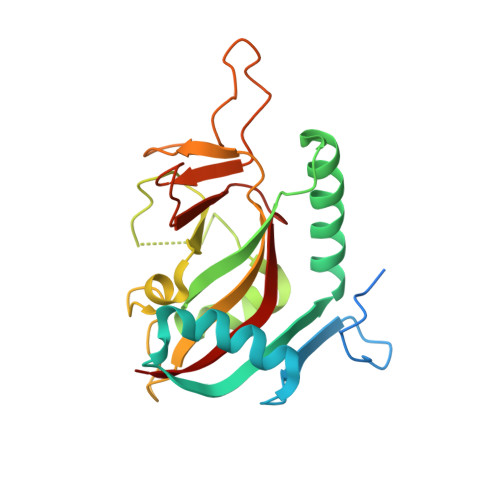Potent 2,3-dihydrophthalazine-1,4-dione derivatives as dual inhibitors for mono-ADP-ribosyltransferases PARP10 and PARP15.
Nizi, M.G., Maksimainen, M.M., Murthy, S., Massari, S., Alaviuhkola, J., Lippok, B.E., Sowa, S.T., Galera-Prat, A., Prunskaite-Hyyrylainen, R., Luscher, B., Korn, P., Lehtio, L., Tabarrini, O.(2022) Eur J Med Chem 237: 114362-114362
- PubMed: 35500474
- DOI: https://doi.org/10.1016/j.ejmech.2022.114362
- Primary Citation of Related Structures:
7PW3, 7PWA, 7PWC, 7PWK, 7PWL, 7PWM, 7PWP, 7PWQ, 7PWR, 7PWS, 7PWU, 7PWW, 7PX6, 7PX7 - PubMed Abstract:
While human poly-ADP-ribose chain generating poly-ARTs, PARP1 and 2 and TNKS1 and 2, have been widely characterized, less is known on the pathophysiological roles of the mono-ADP-ribosylating mono-ARTs, partly due to the lack of selective inhibitors. In this context, we have focused on the development of inhibitors for the mono-ART PARP10, whose overexpression is known to induce cell death. Starting from OUL35 (1) and its 4-(benzyloxy)benzamidic derivative (2) we herein report the design and synthesis of new analogues from which the cyclobutyl derivative 3c rescued cells most efficiently from PARP10 induced apoptosis. Most importantly, we also identified 2,3-dihydrophthalazine-1,4-dione as a new suitable nicotinamide mimicking PARP10 inhibitor scaffold. When it was functionalized with cycloalkyl (8a-c), o-fluorophenyl (8h), and thiophene (8l) rings, IC 50 values in the 130-160 nM range were obtained, making them the most potent PARP10 inhibitors reported to date. These compounds also inhibited PARP15 with low micromolar IC 50 s, but none of the other tested poly- and mono-ARTs, thus emerging as dual mono-ART inhibitors. Compounds 8a, 8h and 8l were also able to enter cells and rescue cells from apoptosis. Our work sheds more light on inhibitor development against mono-ARTs and identifies chemical probes to study the cellular roles of PARP10 and PARP15.
- Department of Pharmaceutical Sciences, University of Perugia, 06123, Perugia, Italy.
Organizational Affiliation:


















